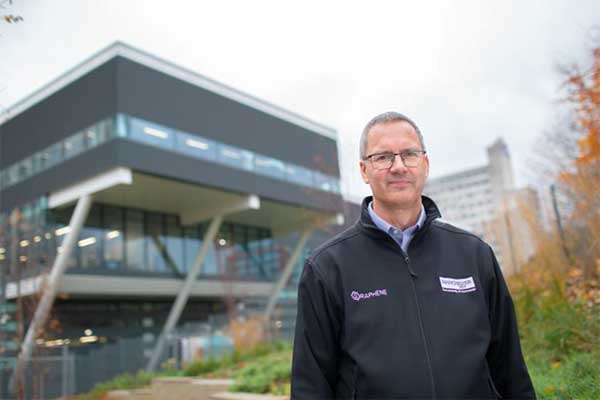
James Baker, Chief Executive Officer, Graphene@Manchester. This includes the Graphene Engineering Innovation Centre (GEIC) and National Graphene Institute (NGI)
This article is based on a conversation between James and Adrian Nixon, Editor of the Nixene Journal
(James Baker in front of the GEIC Building 1 – Image courtesy of the University of Manchester)
James, you gave an excellent opening keynote speech at the recent Graphene Innovation Showcase, what did you mean by graphene entering the impact era?
The impact era for graphene is becoming less about what graphene is and more about what graphene can do. 2019 has been a key year for the acceleration of graphene towards the tipping point where we see it has become embedded in many other products.
People will talk less about graphene as a material in its own right and more about experiencing the benefits of graphene as a performance additive. Can you give us some examples of the impact that graphene has made recently?
Graphene has made a big impact in the automotive sector where it enhances the strength and heat resistance of urethane foams used in the engine compartment. More importantly it also improves the noise reduction of the materials and this means quieter more refined cars. Customers like this and it is a real competitive advantage, in 2019 alone we estimate around one million cars were made with graphene.
Graphene is also being used in mobile phones. Its thermal conductivity makes it an ideal material for the heat spreader. Heat is now dissipated with a solid-state graphene system rather than an expensive and power consuming heat exchanger. This means the phone battery lasts a lot longer than its rivals, again creating a real customer benefit that creates competitive advantage. We estimate over 21 million phones have been made with graphene components.
This is very impressive; how does this connect with the GEIC and Abu Dhabi?
We are at an exciting stage in the development and application of graphene and other 2D materials. Abu Dhabi through Masdar had the foresight to invest in the GEIC and we are housed in the Masdar building in Manchester. We value our partnership with Masdar and Khalifa University of Science and Technology (KUST) These resources have enabled us to connect with the unique pool of talent around the Nobel prizewinning scientists such as Andre Geim. There are 350 people working on graphene in Manchester.
And the role of the GEIC in this?
The GEIC is focussed on commercialising world class science. We aim to be a facilitator for supply chain collaboration sustaining links between the academics exploring the frontiers of science and the industrial companies that will apply this knowledge.
To this end we have developed the Manchester model. This is a flagship for how we commercialise science and be a benchmark method for collaboration. At the GEIC we have the capability to operate at the kilogram and square metre scale. This allows us to rapidly develop and prototype industrial scale applications with a fail fast approach we call Design-Make-Evaluate-Repeat
This means we take new developments from laboratory to market and reduce the time from years to months. This is how we accelerate commercialisation.
What specific areas are you seeking to accelerate?
Standards are really important. We have a collaboration with the National Physical Laboratory (NPL) to develop graphene metrology that will be able to identify and reliably prove the consistency of the products of the future.
We see the big opportunities in Lightweighting, taking weight out of cars, planes and buildings. Reinforcement is an associated area where we can get the same strength using less material and reduce the carbon footprint.
Printed electronics and sensors are another rapidly developing area. We hosted the world’s first graphene hackathon where students worked with the latest graphene conductive inks to invent devices, build working prototypes and pitch the business plans over a 24-hour session. This is one innovative approach to identify and build a pipeline of talent for the future.
Energy storage, in particular supercapacitors and thermal management are other areas where we can advance and test new products and ideas. We also see a huge opportunity for filtration and separation cleaning up dirty water and even scaling up new ways of using graphene and 2D materials for desalination of water.
That was a really comprehensive view of the future impact that you are planning to enable through the collaborative approach centred around the physical and intellectual assets you manage here in Manchester, Thank you James.


© Copyright 2025 Nixene Publishing Privacy Policy Cookie Policy Website Design by Pivotal Marketing